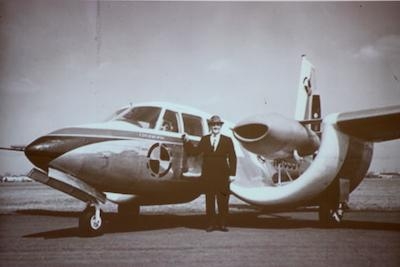Wed, Jul 24, 2019
New Technology Meets Old School
By: Rex Alexander
While accelerating the airflow over the top of the wing of an aircraft to help increase its overall lift is nothing new, it is the advancements in technology such as better electric motors coupled with improvements in ducted fans that is breathing new life into this 1940's tech. This is beginning to make this aviation adaptation look more feasible every day for Short Takeoff and Landing (STOL) aircraft.

In the 1940s and 50s, the process of increasing the airflow over the upper surface of a wing showed great promise in creating aircraft that were capable of slower flight speeds without stalling, steeper approach angles and extremely short takeoff and landing distances. One man who is currently conducting research and testing in this space is Dr. David Ullman who is an Emeritus Professor of Design from Oregon State University and an active electric aircraft designer. According to Dr. Ullman by playing with the aerodynamics of a wing through the application of distributive ducted fans along the leading edge, one has the potential to significantly improve lift in some very interesting ways.
This application could allow for higher fidelity in airflow management to the point that it may be possible to completely eliminate the need for ailerons on aircraft in the future. This is accomplished by independently manipulating the thrust of individual ducted fans installed along a wingís leading edge. In theory, this application could reduce an aircraftís stall speed to as low as 25 knots (28 mph).
While a STOL aircraft does require a certain amount of room to take off and land, this technology could allow for takeoffs in as little as 20 to 80 feet while using 1/5th of the total power required to takeoff vertical at the same location. This huge savings in power would then equate to much greater flight ranges being achievable. Based on current stats, an eVTOL aircraft could have nearly half the range of an eSTOL aircraft.
(Image provided by author)
More News
Aero Linx: Model Aeronautical Association of Australia MAAA clubs are about fun flying, camaraderie and community. For over 75 years, the MAAA has been Australia’s largest fl>[...]
Touchdown Zone Lighting Two rows of transverse light bars located symmetrically about the runway centerline normally at 100 foot intervals. The basic system extends 3,000 feet alon>[...]
“Discovery and innovation are central to our mission at Virgin Galactic. We’re excited to build on our successful record of facilitating scientific experiments in subor>[...]
How To Get A Story On Aero-TV News/Feature Programming How do I submit a story idea or lead to Aero-TV? If you would like to submit a story idea or lead, please contact Jim Campbel>[...]
Student Pilot Reported That During Rotation, “All Of A Sudden The Back Of The Plane Kicked To The Right..." Analysis: The student pilot reported that during rotation, “>[...]
 ANN's Daily Aero-Linx (05.02.24)
ANN's Daily Aero-Linx (05.02.24) ANN's Daily Aero-Term (05.02.24): Touchdown Zone Lighting
ANN's Daily Aero-Term (05.02.24): Touchdown Zone Lighting Aero-News: Quote of the Day (05.02.24)
Aero-News: Quote of the Day (05.02.24) ANN FAQ: Contributing To Aero-TV
ANN FAQ: Contributing To Aero-TV NTSB Final Report: Cirrus Design Corp SR20
NTSB Final Report: Cirrus Design Corp SR20



